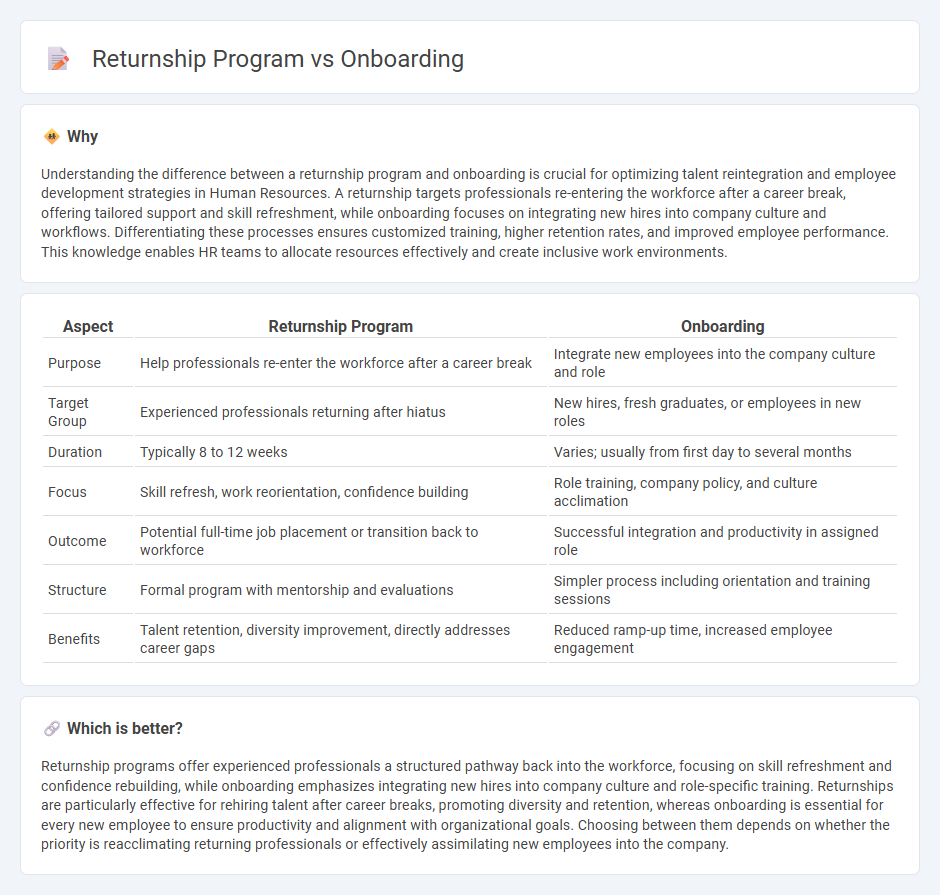
Returnship programs cater specifically to professionals re-entering the workforce after extended career breaks, offering tailored support and skill-refreshing opportunities. Onboarding focuses on integrating new employees into a company's culture, processes, and expectations to ensure a smooth transition. Explore how these distinct approaches can enhance talent retention and workforce diversity.
Why it is important
Understanding the difference between a returnship program and onboarding is crucial for optimizing talent reintegration and employee development strategies in Human Resources. A returnship targets professionals re-entering the workforce after a career break, offering tailored support and skill refreshment, while onboarding focuses on integrating new hires into company culture and workflows. Differentiating these processes ensures customized training, higher retention rates, and improved employee performance. This knowledge enables HR teams to allocate resources effectively and create inclusive work environments.
Comparison Table
| Aspect | Returnship Program | Onboarding |
|---|---|---|
| Purpose | Help professionals re-enter the workforce after a career break | Integrate new employees into the company culture and role |
| Target Group | Experienced professionals returning after hiatus | New hires, fresh graduates, or employees in new roles |
| Duration | Typically 8 to 12 weeks | Varies; usually from first day to several months |
| Focus | Skill refresh, work reorientation, confidence building | Role training, company policy, and culture acclimation |
| Outcome | Potential full-time job placement or transition back to workforce | Successful integration and productivity in assigned role |
| Structure | Formal program with mentorship and evaluations | Simpler process including orientation and training sessions |
| Benefits | Talent retention, diversity improvement, directly addresses career gaps | Reduced ramp-up time, increased employee engagement |
Which is better?
Returnship programs offer experienced professionals a structured pathway back into the workforce, focusing on skill refreshment and confidence rebuilding, while onboarding emphasizes integrating new hires into company culture and role-specific training. Returnships are particularly effective for rehiring talent after career breaks, promoting diversity and retention, whereas onboarding is essential for every new employee to ensure productivity and alignment with organizational goals. Choosing between them depends on whether the priority is reacclimating returning professionals or effectively assimilating new employees into the company.
Connection
Returnship programs enhance onboarding by providing structured support for professionals re-entering the workforce, ensuring a smoother transition and faster integration. These programs offer tailored training and mentorship, aligning returnees' skills with organizational goals to boost productivity and retention. Effective onboarding in returnship initiatives reduces onboarding time and increases employee engagement by addressing unique challenges faced by returning employees.
Key Terms
**Onboarding:**
Onboarding programs are designed to seamlessly integrate new hires into a company's culture, processes, and tools, ensuring they become productive swiftly. They typically include orientation sessions, training modules, and mentorship opportunities, facilitating smooth transitions and alignment with organizational goals. Explore more about how effective onboarding accelerates employee success and retention.
Orientation
Onboarding programs prioritize comprehensive orientation sessions to seamlessly integrate new hires by covering company culture, job responsibilities, and key policies. Returnship programs focus orientation on upskilling and addressing skill gaps for professionals re-entering the workforce after an extended break. Explore detailed comparisons to understand which orientation approach best suits your organizational needs.
Training
Onboarding programs prioritize comprehensive training to integrate new employees into company culture and workflows efficiently, often including role-specific skill development and compliance education. Returnship programs focus on upskilling and reskilling experienced professionals re-entering the workforce, emphasizing current industry practices and technological advancements to bridge skill gaps. Explore detailed comparisons to understand which training approach suits your organizational needs best.
Source and External Links
Complete Employee Onboarding Guide - SHRM - Onboarding is the process of integrating new employees into an organization through orientation, cultural assimilation, and functional training, often including tours, mentoring, and innovative approaches like team-building exercises to ensure new hires are productive and engaged from day one.
What Is Onboarding? (Definition, Process, Examples) | Built In - Onboarding helps new employees integrate by providing access to tools, policies, team introductions, and regular check-ins, which improves retention and productivity, especially important in today's hybrid and remote work environments.
What Are The 4Cs of Onboarding and How to Implement Them - The 4Cs framework--Compliance, Clarification, Culture, and Connection--guides effective onboarding by ensuring legal requirements, clear role expectations, company culture understanding, and social connections are all addressed for new hires.
 dowidth.com
dowidth.com